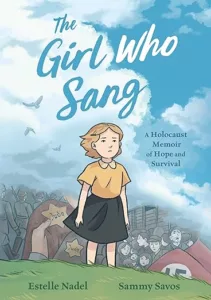The Girl Who Sang: A Holocaust Memoir of Hope and Survival
Estelle Nadel
Illustrated by Sammy Savos
Edited by Bethany Strout
Roaring Brook Press
Published January 23, 2024
Amazon | Bookshop | Goodreads
About The Girl Who Sang: A Holocaust Memoir of Hope and Survival
A heartrending graphic memoir about a young Jewish girl’s fight for survival in Nazi-occupied Poland, THE GIRL WHO SANG illustrates the power of a brother’s love, the kindness of strangers, and finding hope when facing the unimaginable.
Born to a Jewish family in a small Polish village, Estelle Nadel―then known as Enia Feld―was just seven years old when the Nazis invaded Poland in 1939. Once a vibrant child with a song for every occasion, Estelle would eventually lose her voice as, over the next five years, she would survive the deaths of their mother, father, their eldest brother and sister, and countless others.
A child at the mercy of her neighbors during a terrifying time in history, THE GIRL WHO SANG is an enthralling first-hand account of Estelle’s fight for survival during World War II. She would weather loss, betrayal, near-execution, and spend two years away from the warmth of the sun―all before the age of eleven. And once the war was over, Estelle would walk barefoot across European borders and find remnants of home in an Austrian displaced persons camp before finally crossing the Atlantic to arrive in New York City―a young woman carrying the unseen scars of war.
Beautifully rendered in bright hues with expressive, emotional characters, debut illustrator Sammy Savos masterfully brings Estelle’s story of survival during the Holocaust to a whole new generation of readers. THE GIRL WHO SANG is perfect for fans of MARCH, MAUS, and ANNE FRANK’S DIARY.
My Review
What a powerful first-hand account of survival during the Nazi occupation of Poland. In the opening pages, we meet Enia’s family and see the quiet life they live in their small town. Then, as the Nazis invade, things change. Her family must hide. Enia feels afraid. She loses so many people, but always, when she needs help, someone steps up to help her.
Some of the scenes in the book are pretty chilling. There’s one brief series of panels that shows, from a distance, soldiers lining people up against a building. In the next image, red smudges the wall of the building, and the people are shown collapsed on the ground. The viewer easily understands they’ve been shot to death.
Thinking about this tiny girl never speaking above a whisper or standing up while she was in hiding can’t help but break your heart. Thinking about her brother, who was only a few years older than she was, risking his life several times a week to look for food is also heartbreaking. I can’t begin to think about how I would process that anxiety– both from being the person going out and the person left behind. The resilience and devotedness of these siblings leaves me in awe.
I also love the decision to tell this story as a graphic memoir. Not only do the illustrations help to anchor the story in its setting, but they carefully lay out the story without needing to graphically describe some of the horrors Estelle and her family endured.
I think readers who were moved by THE LIBRARIAN OF AUSCHWITZ: THE GRAPHIC ADAPTATION or the graphic adaptations mentioned in the book description above will find this story equally moving and important.
Content Notes
Recommended for Ages 10 up.
Representation
Estelle (called Enia in the early pages of the book) and her family are Jewish and Polish.
Profanity/Crude Language Content
None.
Romance/Sexual Content
Enia believes her older sister and her sister’s sweetheart will get married.
She describes how her family used public showers in town once per week as part of getting ready for the Sabbath. One image shows a vague representation from a distance of Enia and her mother readying for a shower.
Spiritual Content
Enia celebrates Shabbat and Passover with her family. She also learns to prepare food according to Jewish rules so that the food is kosher.
Violent Content
Soldiers ransack Enia’s house, looking for valuables.
There’s one brief series of panels that shows, from a distance, soldiers lining people up against a building. In the next image, red smudges the wall of the building, and the people are shown collapsed on the ground. The viewer easily understands they’ve been shot to death. Enia is told that her mother was beaten by soldiers and likely shot to death the next morning. She’s told that other family members were shot as well and later learns they were killed in a gas chamber.
At one point, Enia witnesses soldiers beating her brother and begs for them to stop. The panels show simplified images that hint at the violence without being gratuitous.
Drug Content
None.
Note: This post contains affiliate links, which do not cost you anything to use, but which help support this blog. I received a free copy of THE GIRL WHO SANG in exchange for my honest review.
